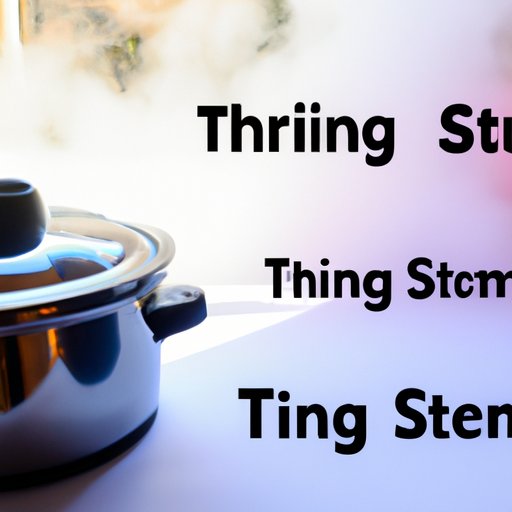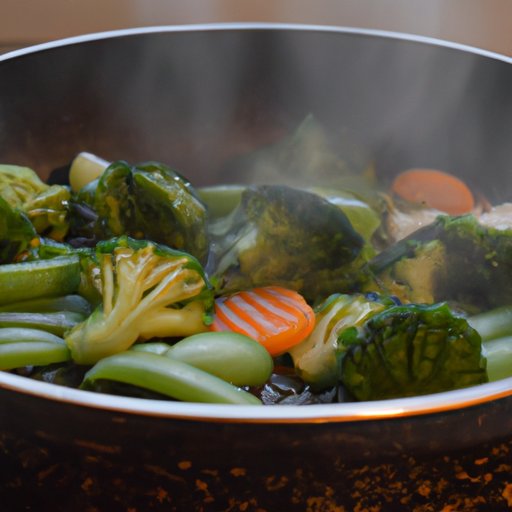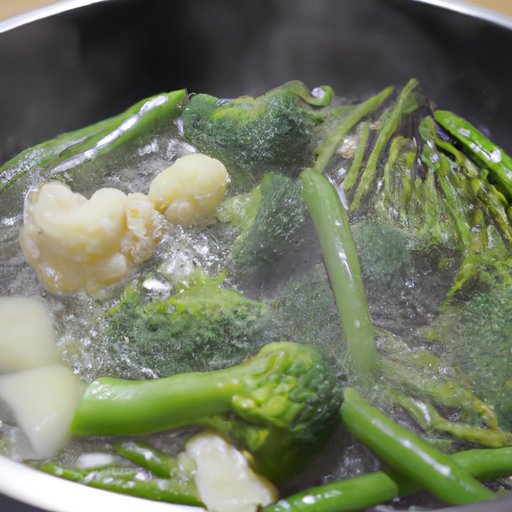Introduction
Healthy eating habits are important for maintaining a healthy lifestyle. Eating plenty of fruits and vegetables is a great way to get the vitamins and minerals your body needs to stay healthy. But what about cooking methods? Is steaming vegetables better than boiling them? This article will explore the nutritional benefits of steamed vegetables and discuss whether they are a healthier alternative to boiled vegetables.
Analyzing the Nutritional Benefits of Steamed Vegetables
Steamed vegetables are an excellent source of vitamins and minerals. They retain most of their nutrients when cooked, making them a healthier option than boiled vegetables. The nutrient content of steamed vegetables varies depending on the type of vegetable being cooked, but generally they are high in fiber, vitamins A and C, iron, magnesium, and potassium.
Vitamins and minerals found in steamed vegetables include beta carotene (vitamin A), vitamin C, folate, and calcium. Beta carotene helps to protect against diseases such as cancer and heart disease, while vitamin C helps to strengthen the immune system. Folate is important for cell growth and development, and calcium helps to maintain strong bones and teeth.
One of the advantages of steaming over other cooking methods is that it helps to preserve the nutrients in the vegetables. When vegetables are boiled, some of the nutrients are lost in the cooking water. With steaming, the heat from the steam cooks the vegetables without exposing them to too much water, so more of the nutrients are retained.
Comparing Steamed and Raw Vegetables: What’s Healthier?
Raw vegetables are often touted as being the healthiest option, but is this really true? While raw vegetables are a good source of vitamins and minerals, they can also contain harmful bacteria and parasites that can make you sick. Cooking vegetables can help to reduce these risks, as well as make them easier to digest.
The nutritional value of raw vegetables depends on the type of vegetable being eaten. For example, raw spinach has more vitamin C than cooked spinach, while cooked carrots have more vitamin A than raw carrots. So while raw vegetables may be slightly more nutritious than cooked ones, the difference is usually small.
There are pros and cons to eating raw vegetables. On the plus side, they are easy to prepare and don’t require any special cooking skills. They are also a good source of fiber, which is important for healthy digestion. On the downside, they can be difficult to digest and may contain harmful bacteria and parasites.

Exploring the Health Benefits of Steaming as a Cooking Method
Steaming is one of the healthiest ways to cook vegetables. The heat of the steam gently cooks the vegetables without exposing them to too much water, which helps to preserve their nutrients. Steaming also helps to keep the vegetables crisp and crunchy, so they still have a good texture and flavor.
How does steaming preserve nutrients? When vegetables are boiled, some of the vitamins and minerals leach out into the cooking water. With steaming, the heat from the steam is enough to cook the vegetables without exposing them to too much water, so more of the nutrients are retained.
Another advantage of steaming over boiling is that it helps to prevent the vegetables from becoming soggy and losing their flavor. Boiling can cause vegetables to become mushy and lose their flavor, but steaming helps to preserve their texture and taste.
Steamed Vegetables: A Healthier Alternative to Boiled?
When comparing steamed and boiled vegetables, it’s clear that steaming is the healthier option. Steamed vegetables retain more of their vitamins and minerals than boiled vegetables, and they also have a better texture and flavor. Steaming is also a quicker and easier way to cook vegetables, so it’s a great option for busy people who want to eat healthier.
When it comes to nutritional differences between steamed and boiled vegetables, there are several factors to consider. For example, steamed vegetables tend to have higher levels of vitamin C and folate, while boiled vegetables are higher in calcium and iron. So while both cooking methods can provide valuable nutrients, steaming is generally the healthier option.
There are also several reasons why steaming is preferable to boiling. For starters, steaming helps to preserve the nutrients in the vegetables, so they retain more of their vitamins and minerals. It also helps to prevent the vegetables from becoming soggy and losing their flavor, and it’s a quicker and easier way to cook vegetables.
What Are the Pros and Cons of Eating Steamed Vegetables?
Eating steamed vegetables has many advantages. For one, it’s a great way to get more vitamins and minerals into your diet. Steaming also helps to preserve the nutrients in the vegetables, so you get more nutritional benefit from them. Plus, steaming is a quick and easy way to cook vegetables, so it’s a great option for busy people who want to eat healthier.
On the downside, steamed vegetables can sometimes be bland and unappetizing. If you’re not used to eating steamed vegetables, it can take some getting used to. Additionally, steaming can sometimes cause vegetables to lose some of their flavor, so you may need to add herbs or spices to bring out their natural flavors.

Steaming Vegetables: An Easy Way to Eat Healthier
Steaming vegetables is an easy way to eat healthier. It’s a quick and convenient way to get more vitamins and minerals into your diet, and it helps to preserve the nutrients in the vegetables so you get more nutritional benefit from them. Plus, steaming helps to prevent the vegetables from becoming soggy and losing their flavor.
If you’re new to steaming vegetables, here are a few tips to get you started. First, make sure you have a steamer basket or pot with a lid. You’ll also need to choose the right vegetables for steaming. Some vegetables, like broccoli and cauliflower, are best steamed while others, like potatoes and carrots, are better boiled. Finally, experiment with different herbs and spices to add flavor to your steamed vegetables.
Conclusion
In conclusion, steamed vegetables are a healthy and tasty way to get more vitamins and minerals into your diet. They retain more of their nutrients than boiled vegetables, and they also have a better texture and flavor. Steaming is also a quicker and easier way to cook vegetables, so it’s a great option for busy people who want to eat healthier.
(Note: Is this article not meeting your expectations? Do you have knowledge or insights to share? Unlock new opportunities and expand your reach by joining our authors team. Click Registration to join us and share your expertise with our readers.)
